| Name: | Chicken Polyclonal to Ubiquitin C-Terminal Hydrolase 1 (UCHL1) |
| Immunogen: | Recombinant full length human UCHL1 expressed in and purified from E. coli. |
| HGNC Name: | UCHL1 |
| UniProt: | P09936 |
| Molecular Weight: | 24kDa |
| Host: | Chicken |
| Isotype: | |
| Species Cross-Reactivity: | Human, rat, mouse, cow, pig, horse |
| RRID: | AB_2572393 |
| Format: | Concentrated IgY preparation in PBS plus 0.02% NaN3 |
| Applications: | WB, IF/ICC, IHC |
| Recommended Dilutions: | WB: 1:2,000-5,000. IF/ICC: 1:500-1,000. IHC not recommended |
| Storage: | Store at 4°C |

Immunofluorescent analysis of cortical neuron-glial cell culture from E20 rat stained with chicken pAb to UCHL1, CPCA-UCHL1 , dilution 1:500 in red, and costained with mouse mAb to vimentin, MCA-2A52, dilution 1:2,000, in green. The blue is Hoechst staining of nuclear DNA. The UCHL1 antibody produces strong staining of the cell body and dendrites in neurons. The vimentin antibody stains intermediate filaments in fibroblastic and developing glial cells.
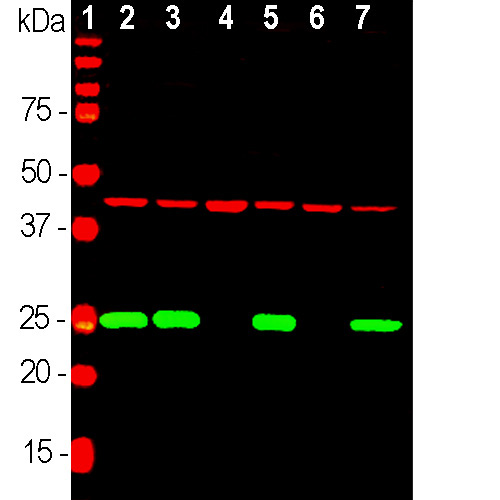
Western blot analysis of equal amounts of different tissue and cell lysates using chicken pAb to UCHL1, CPCA-UCHL1, dilution 1:2,000 in green, and mouse mAb to Actin, MCA-5J11, dilution 1:1,000, in red: [1] protein standard, [2] rat brain, [3] mouse brain, [4] NIH-3T3, [5] HEK293, [6] HeLa and [7] SH-SY5Y cells. The single band at 24 kDa mark corresponds to UCHL1 protein which is detectable in CNS extracts and lysates of cells with neuronal properties.
Chicken Polyclonal Antibody to UCHL1
Cat# CPCA-UCHL1
$120.00 – $800.00
Ubiquitin C-terminal hydrolase 1 (UCHL1) is an extremely abundant protein of brain, where it is localized only in neurons. It was originally named PGP9.5 and discovered as a major protein spot on 2D gels of brain extracts which was absent on similar gels of other tissues (1). Later it was found that the PGP9.5 protein was an enzyme which could cleave ubiquitin monomers from ubiquitin conjugates and polyubiquitin chains, resulting in recycling of ubiquitin monomers and the renaming of PGP9.5 to UCHL1 to reflect this enzymatic activity (2). UCHL1 is an essential enzyme and defects in UCHL1 protein expression are involved in Parkinson’s disease (PD) and other more serious disease states (3-6). Genetic studies defined defects in the PARK5 gene as causative of PD in a German family, the PARK5 gene encoding UCHL1 (7). In addition UCHL1 may be released into cerebrospinal fluid (CSF) and blood following CNS damage and disease resulting in neuronal loss. As a result detection of this protein may give information about CNS compromise and recovery (8,9).
The CPCA-UCHL1 antibody was made against full length recombinant human UCHL1 expressed in and purified from E. coli and can be used to identify neurons and their processes in culture or in sections. The immunogen used to generate this antibody is available from EnCor, PROT-r-UCHL1. The antibody works cleanly on western blots of appropriate lysates of cell and tissues. It works well for IF and ICC but is not recommended for IHC. Considerable interest has been focused on the detection of UCHL1 in the blood and CSF of patients with traumatic injuries to the brain or spinal cord. This antibody has been widely used as both a capture and a detection reagent in ELISA type assays for measuring UCHL1 levels in blood and CSF samples. In addition we supply a rabbit polyclonal antibody to UCHL1, RPCA-UCHL1, and also a widely used mouse monoclonal MCA-BH7. We also supply an ELISA kit for the detection of UCHL1 in blood, CSF and other biological fluids, ELISA-UCHL1. Mouse select image at left for larger view.
Ubiquitin C-terminal hydrolase 1 (UCHL1) has several other names, such as ubiquitin carboxyl esterase L1, ubiquitin thiolesterase, neuron-specific protein PGP9.5 and Park5. It was originally identified as a major component of the neuronal cytoplasm from 2-dimensional gel analysis of brain tissues, and was given the name PGP9.5 (1). The protein is extremely abundant, and was estimated to be present at a concentration of 200-500 µg/g wet weight in brain, representing a major protein component of neuronal cytoplasm (1). This has been claimed to represent 1-2% of total brain protein. It was later found that a ubiquitin C-terminal hydrolase enzyme activity was associated with the PGP9.5 protein, resulting in the renaming of PGP9.5 to ubiquitin C-terminal hydrolase 1.
This is the first of a family of ubiquitin C-terminal hydrolases which have been characterized, and is expressed heavily in neurons in the brain. The ubiquitin C-terminal hydrolases cleave ubiquitin from other molecules. This activity is important to generate mono-ubiquitin from genes which encode polyubiquitin chains or ubiquitin fused to other proteins. The activity is also important to remove ubiquitin from partially degraded proteins, allowing the ubiquitin monomer to be recycled. Regulation of the ubiquitin pathway is very important and many disease states are associated with defects in this pathway. The covalent ubiquitin conjugates may then be degraded in the proteasome.
Point mutations in the UCHL1 gene are associated with some forms of human Parkinson’s disease (3). Recent studies suggest that UCHL1 also has a ubiqitinyl ligase activity, being able to couple ubiquitin monomers by linking the C-terminus of one with lysine 63 of the other (3). Since UCHL1 is heavily expressed in neurons, antibodies to UCHL1 can be used to identify neurons in histological sections and in tissue culture. The great abundance of this protein in neurons means that it is released from neurons in large amounts following injury or degeneration, so the detection of of UCHL1 in CSF and other bodily fluids can be used as a biomarker.
UCHL1 was also discovered as a gene mutated in some rare familial forms of Parkinson’s disease. Park5 was characterized as the gene causative of this form of Parkinson’s and on analysis the Park5 gene proved to encode an I93M point mutations in the UCHL1 gene, which reduces the ubiquitin hydrolase activity. Interestingly a common allelic variant of UCHL1, the S18Y polymorphism is actually protective against Parkinson’s disease. For a recent excellent review co-authored by the discoverer of UCHL1/Pgp9.5 see reference 4.
1. Doran JF, Jackson P, Kynoch PA, Thompson RJ. Isolation of PGP 9.5, a new human neurone-specific protein detected by high-resolution two-dimensional electrophoresis J Neurochem. 40:1542-7 (1983).
2. Wilkinson KD, et al. The neuron-specific protein PGP 9.5 is a ubiquitin carboxyl-terminal hydrolase. Science 246:670-3 (1989).
3. Kurihara LJ, Kikuchi T, Wada K, Tilghman SM. Loss of Uch-L1 and Uch-L3 leads to neurodegeneration, posterior paralysis and dysphagia. Hum. Mol. Genet. 10:1963-70 (2001).
4. Maraganore DM, et al. UCHL1 is a Parkinson’s disease susceptibility gene. Ann Neurol. 55:512-21 (2004).
5. Bilguvar K, et al. Recessive loss of function of the neuronal ubiquitin hydrolase UCHL1 leads to early-onset progressive neurodegeneration. PNAS 110:3489-94 (2013).
6. Liu Y, et al. The UCH-L1 gene encodes two opposing enzymatic activities that affect alpha-synuclein degradation and Parkinson’s disease susceptibility. Cell 111:209-18 (2002).
7. Leroy E, et al. The ubiquitin pathway in Parkinson’s disease. Nature 395:451-2 (1998).
8. Day IN, Thompson RJ. UCHL1 (PGP 9.5): Neuronal biomarker and ubiquitin system protein. Prog. Neurobiol. 90:327-62 (2009).
9. Mondello S, et al. Clinical utility of serum levels of ubiquitin C-terminal hydrolase as a biomarker for severe traumatic brain injury. Neurosurgery 70:666-75 (2012).
Related products
-
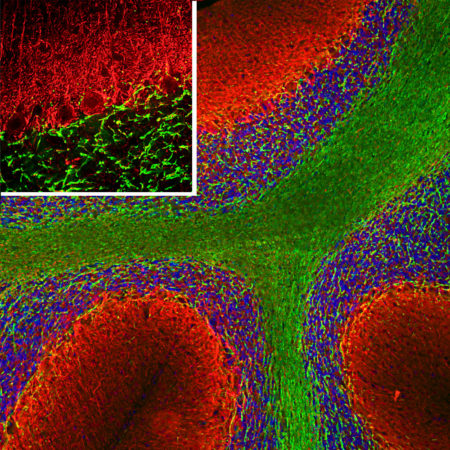
Chicken Polyclonal Antibody to α-Internexin
$120.00 – $800.00
Cat# CPCA-a-IntSelect options This product has multiple variants. The options may be chosen on the product page -
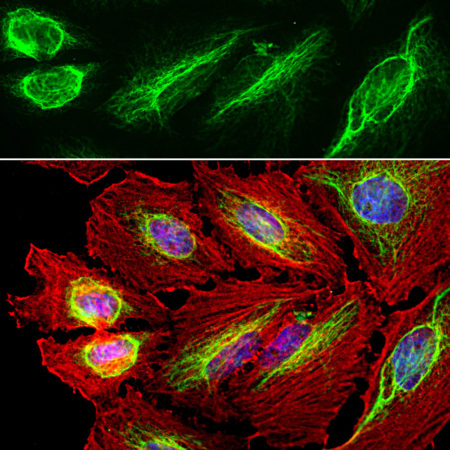
Chicken Polyclonal Antibody to Vimentin
$120.00 – $800.00
Cat# CPCA-VimSelect options This product has multiple variants. The options may be chosen on the product page -
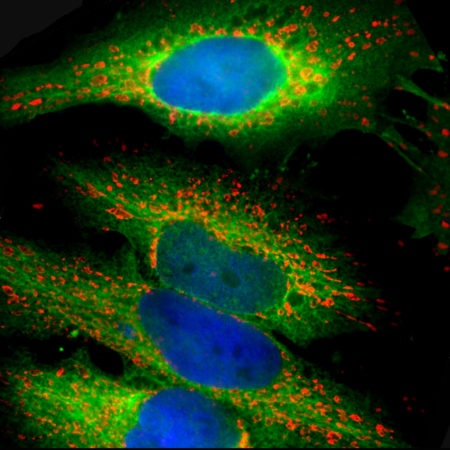
Chicken Polyclonal Antibody to HSP27
$120.00 – $800.00
Cat# CPCA-HSP27Select options This product has multiple variants. The options may be chosen on the product page -
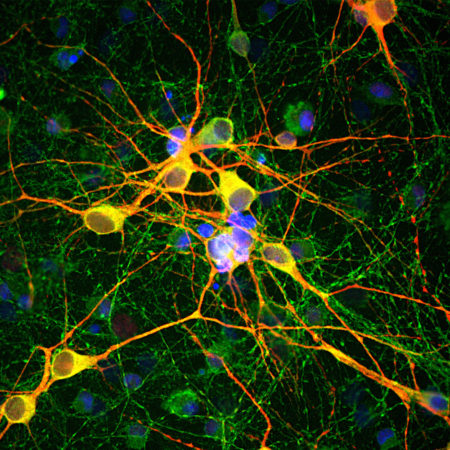
Chicken Polyclonal Antibody to MAP2A/B
$150.00 – $1,000.00
Cat# CPCA-MAP2Select options This product has multiple variants. The options may be chosen on the product page
Contact info
EnCor Biotechnology Inc.
4949 SW 41st Boulevard, Ste 40
Gainesville
Florida 32608 USA
Phone: (352) 372 7022
Fax: (352) 372 7066
E-mail: admin@encorbio.com


